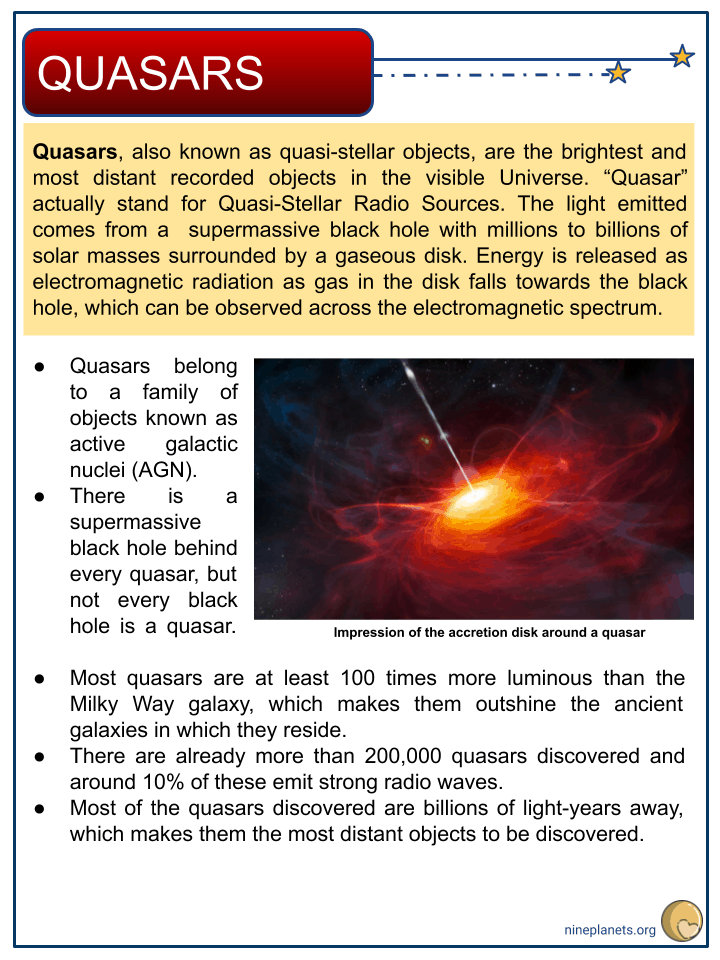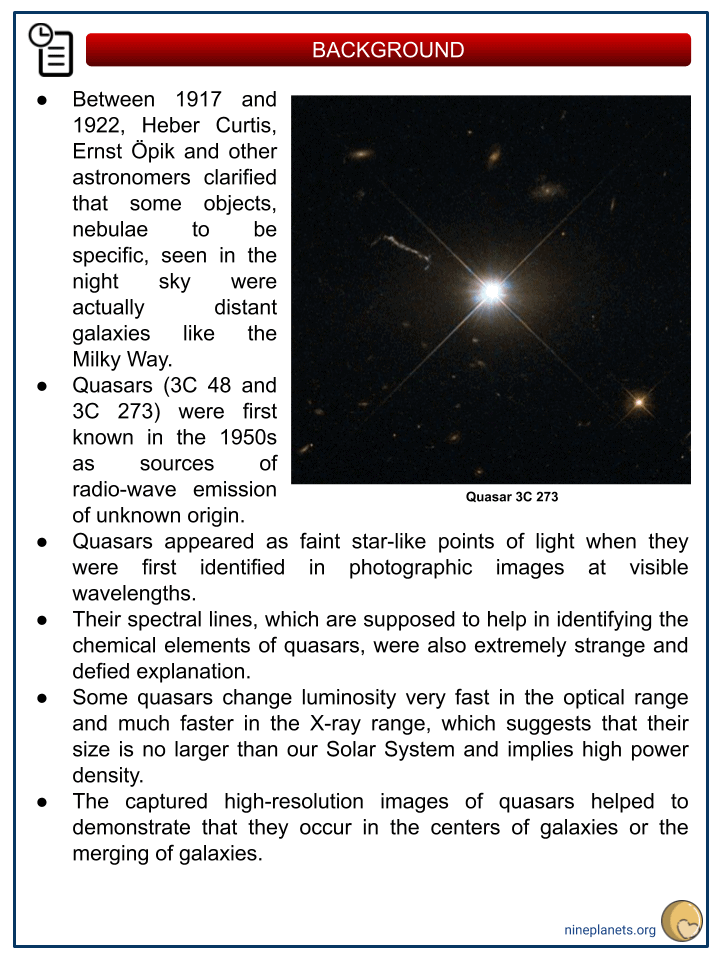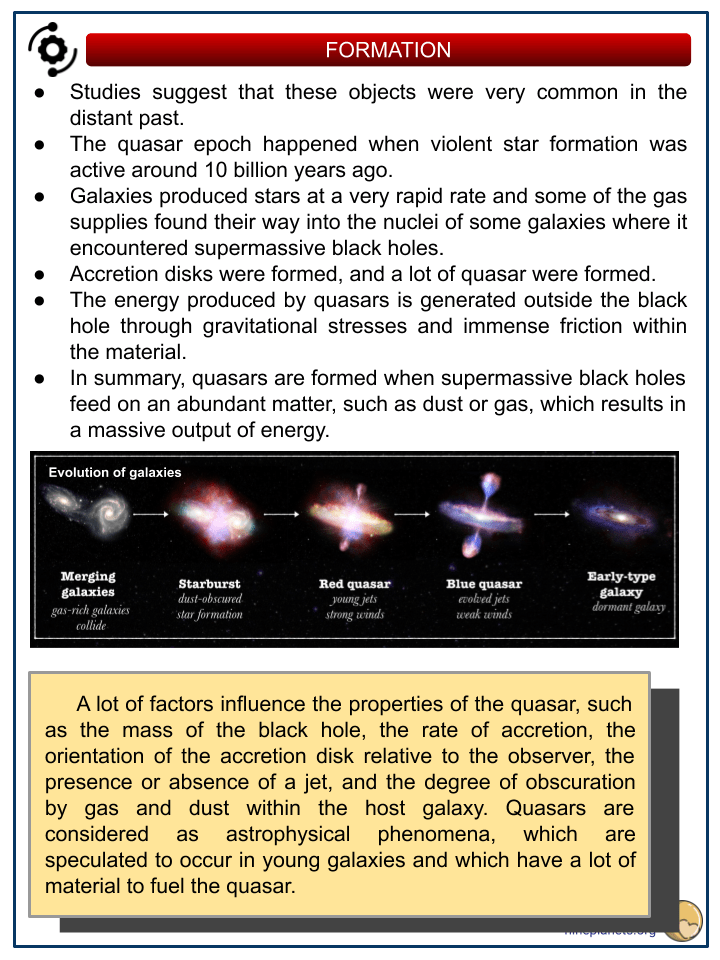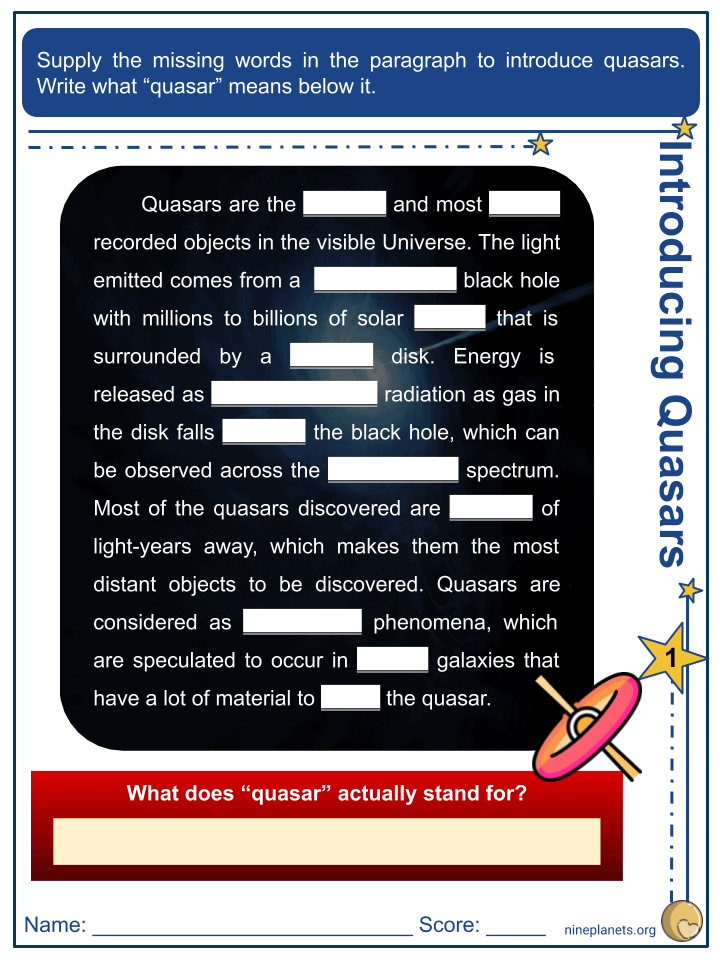Download Quasars Worksheets
Click the button below to get instant access to these premium worksheets for use in the classroom or at a home.

This worksheet can be edited by Premium members using the free Google Slides online software. Click the Edit button above to get started.
Download free sample
Not ready to purchase a subscription yet? Click here to download a FREE sample of this worksheet pack.
Resource Examples
Click any of the example images below to view a larger version.




Key Facts & Information
- Quasars, also known as quasi-stellar objects, are the brightest and most distant recorded objects in the visible Universe. “Quasar” actually stand for Quasi-Stellar Radio Sources. The light emitted comes from a supermassive black hole with millions to billions of solar masses surrounded by a gaseous disk. Energy is released as electromagnetic radiation as gas in the disk falls towards the black hole, which can be observed across the electromagnetic spectrum.
- Quasars belong to a family of objects known as active galactic nuclei (AGN).
- There is a supermassive black hole behind every quasar, but not every black hole is a quasar.
- Most quasars are at least 100 times more luminous than the Milky Way galaxy, which makes them outshine the ancient galaxies in which they reside.
- There are already more than 200,000 quasars discovered and around 10% of these emit strong radio waves.
- Most of the quasars discovered are billions of light-years away, which makes them the most distant objects to be discovered.
Background
- Between 1917 and 1922, Heber Curtis, Ernst Öpik and other astronomers clarified that some objects, nebulae to be specific, seen in the night sky were actually distant galaxies like the Milky Way.
- Quasars (3C 48 and 3C 273) were first known in the 1950s as sources of radio-wave emission of unknown origin.
- Quasars appeared as faint star-like points of light when they were first identified in photographic images at visible wavelengths.
- Their spectral lines, which are supposed to help in identifying the chemical elements of quasars, were also extremely strange and defied explanation.
- Some quasars change luminosity very fast in the optical range and much faster in the X-ray range, which suggests that their size is no larger than our Solar System and implies high power density.
- The captured high-resolution images of quasars helped to demonstrate that they occur in the centers of galaxies or the merging of galaxies.
Formation
- Studies suggest that these objects were very common in the distant past.
- The quasar epoch happened when violent star formation was active around 10 billion years ago.
- Galaxies produced stars at a very rapid rate and some of the gas supplies found their way into the nuclei of some galaxies where it encountered supermassive black holes.
- Accretion disks were formed, and a lot of quasar were formed.
- The energy produced by quasars is generated outside the black hole through gravitational stresses and immense friction within the material.
- In summary, quasars are formed when supermassive black holes feed on an abundant matter, such as dust or gas, which results in a massive output of energy.
- A lot of factors influence the properties of the quasar, such as the mass of the black hole, the rate of accretion, the orientation of the accretion disk relative to the observer, the presence or absence of a jet, and the degree of obscuration by gas and dust within the host galaxy. Quasars are considered as astrophysical phenomena, which are speculated to occur in young galaxies and which have a lot of material to fuel the quasar.
Properties
- Quasars were known to exist in the early ages of the universe and some exist in young galaxies which have enough material to form quasars.
- Supermassive black holes are known to be the real power behind the formation of quasars.
- Quasars are known to be immensely bright, for instance, the 3C 273 is around 4 trillion times brighter than our Sun.
- If the said quasar is just 33 light-years away from us, it would act as our sun.
- These objects emit radiating energy in all directions.
- However, quasars that have jets radiate primarily in their direction.
- The emitted light is variable and the mass that falls into the black hole is converted between 6% and 32% into energy.
- This process is unique due to the high-power formation of quasars over a long period of time.
- Quasars are known to emit a thousand times the energy output of the Milky Way.
- The radiation is emitted across the electromagnetic spectrum, from X-rays to the far infrared with a peak of UV optical bands.
- Some quasars are also strong sources of radio emission and gamma rays.
- A few quasars exhibit strong radio emissions, which are generated by the jets of matter moving about the speed of light.
- When viewed downward, they appear as blazars and often have regions which seem to move away from the center faster than the speed of light.
- This optical illusion is due to the properties of special relativity.
- The redshifts of quasars are measured from the strong spectral lines which dominate their visible and ultraviolet spectra.
- They exhibit Doppler broadening corresponding to mean speed of about the speed of light.
Quasar Subtypes
- The taxonomy of quasars involves different subtypes that represent subsets of the quasar population having distinct properties.
- Radio-loud Quasars – have powerful jets, which are strong sources of radio-wavelength emission. These types of quasars make up about 10% of the overall quasar population.
- Radio-quiet Quasars – lack powerful jets with relatively weaker radio emission compared to the radio-loud quasars. They make up about 90% of the population of quasars
- Broad absorption-line (BAL) Quasars – their spectrum has broad absorption lines that are blueshifted relative to the quasars rest frame, which results from the gas flowing outward from the active nucleus toward the observer. Broad absorption lines are found in around 10% of the quasar population and are usually radio-quiet. In rest-frame UV spectrum, broad absorption lines can be detected from ionized carbon, magnesium, silicon, nitrogen, and other elements.
- Type 2 Quasars – their accretion disk and broad absorption lines are highly obscured by dense gas and dust. These types of quasars are known as the higher-luminosity counterparts of the Type 2 Seyfert galaxies.
- Red Quasars – have optical colors that are redder compared to normal quasars, which is speculated to be the result of moderate levels of dust extinction within the host galaxy. Infrared surveys present that red quasars make up a substantial fraction of the total quasar population.
- Optically Violent Variable (OVV) Quasars – radio-loud quasars in which the jet is directed toward the observer. Strong and rapid variability of the quasar brightness is due to the relativistic beaming of the emission. These quasars are also considered to be a type of blazar.
- Weak Emission Line Quasars – have unusually faint emission lines in the UV or visible spectrum.
Famous Quasars
- Twin Quasar was the first identified gravitationally lensed object discovered in 1979.
- It appears as two images due to the gravitational lensing caused by the galaxy YGKOW G1 located in line of sight between earth and the quasar.
- QSO 0957+561 A and QSO 0957+561 B are the two components of the double-imaged quasar.
- The twin quasar is located about 8.7 billion light-years away from us with an apparent magnitude of 16.7, and YGKOW G1 is 3.7 billion light-years away.
- Einstein Cross is a gravitationally lensed quasar that sits directly behind Huchra’s lens discovered by John Huchra and his colleagues in 1985.
- There are four images of the quasar that appear around a foreground galaxy due to strong gravitational lensing and a dim one at the center.
- The quasar is speculated to be located around 8 billion light-years from us with an 16.78 apparent magnitude, while the lensing galaxy is around 400 million light-years away.
- Cloverleaf is the brightest known high-redshift source of CO emission.
- It was discovered in 1988 with 4 quasar images.
- Gravitational microlensing is speculated to increase the magnification of the X-ray light of the quasar.
- The said event occurs when a star or a star system passes in front of light from a background object.
- Triple Quasar, or PG1115+080, is the second gravitationally lensed quasar discovered.
- It was originally discovered as 3 lensed images, and the fourth image is faint.
- The quasar is viewed through an elliptical galaxy lens at a distance of 3 billion light-years.
- Teacup Galaxy is a low redshift type 2 quasar discovered by volunteers of the Galaxy Zoo project and labeled as a Voorwerpje.
- The quasar shows an extended loop of ionized gas which resembles a handle of a teacup.
- The handle is a bubble shaped by quasar winds or small-scale radio jets
- Naked Quasar, or HE0450-2958, is the first quasar discovered to seemingly not have a host galaxy located at about 3 billion light-years away from us.
- Due to this, it is also called the “quasar without a home”.
- 3C 279 is the first quasar with superluminal jets discovered in 1973.
- It is an OVV quasar that has variable visible, radio, and X-ray bands.
- The quasar was used as a calibrator source for Event Horizon Telescope observations of M87, which resulted in the first image of a black hole.
- QSR J1819+3845 is a quasar that proved interstellar scintillation due to the interstellar medium.
- It was also notable for being the most variable known extragalactic radio source.
- TON 618 is an extremely luminous quasar located around 10.4 billion light-years away from us.
- It is actually a hyper-luminous, broad-absorption-line, radio-loud quasar.
- It is also currently the most massive black hole discovered with 66 billion solar masses.
- CID-42 is a galaxy quasar located about 3.9 billion light-years away and is believed to host a supermassive black hole at its center.
- The quasar is speculated to be a result of a collision between two smaller galaxies.
- QSO B1359+154 is the first sextuply-imaged galaxy.
- A group of three foreground galaxies at a redshift of about 1 acts as gravitational lenses which results in a rare example of a sixfold multiply-imaged quasar.
- RX J1131-1231 is a supermassive black hole that has a quasar located about 6 billion light-years from us.
- The host galaxy is also lensed into Einstein’s ring and the four images of the quasar are embedded in the ring image.
- 3C 47 is the first quasar discovered with the classic double radio-lobe structure.
- It is actually a Seyfert galaxy located in the constellation of Pisces around 4.3 billion light-years away from us.
Did You Know?
- The discovery of quasars somehow helped in presenting that most galaxies have supermassive black holes at their centers.
- The jets emitted by quasars do not originate from the center of a black hole, but are rather emitted from the spinning disc of gas and dust that gradually fell down into the black hole.
- These jets are very powerful and can extend up to 1.5 million light-years into the stellar space. Due to this, massive hotspots are created which are named Double Radio Source Active Galactic Nucleus (DRAGN).
- Some quasars burn around 1,000 solar masses every year.
- Some of the largest quasars eat up mass equivalent to around 600 earth masses every day.
- If quasars were as common now as they were during the early times of the universe, life would probably cease to exist.
Future
- It is speculated that a new quasar will be born when the Andromeda galaxy and the Milky Way collide.
- Our understanding about quasars is slowly improving, and in the near future, quasars are believed to reveal information about the distant past of the universe.
- Quasars are currently moving away from us at a speed almost approaching that of light.